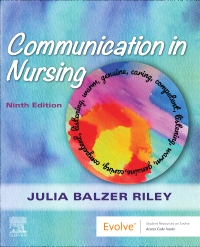
Communication in Nursing - Elsevier eBook on VitalSource, 9th Edition
Elsevier eBook on VitalSource

Immerse your nursing students in the ideas, theories, and techniques of effective communication in the workplace! Communication in Nursing, 9th Edition adopts a uniquely practical and personal approach to the demands of today’s nursing practice, providing extensive examples, exercises, and techniques that help students apply communication skills in a variety of clinical settings. Using a conversational tone, this relatable text takes your students beyond theory to show them how to understand important concepts and use communication as a tool to limit stress in their nursing practice. The 9th edition includes a new chapter which focuses on the foundation of communication and personality assessment. It also includes a new Putting it into Practice feature to help students learn to apply their new communication skills in the work environment. In addition, updates on the topics of mindfulness, resilience, and inter-collaborative communication highlight the importance of implementing these tools in practice.
-
- NEW! Starting with You chapter focuses on personality assessment using the Gallup CliftonStrengths among additional assessment methods
- Two chapters have been combined to create a new one titled, Communicating Assertively and Responsibly with "Difficult" Clients and Colleagues, to help students better address aggressive and difficult clients and colleagues
- UPDATED! Digital Communication and Understanding Each Other chapters have been extensively updated to reflect the most recent information and research on these topics
- NEW! Chapter exercises incorporate teaching strategies such as cinemeducation and medical improvisation to help facilitate various learning types
- UPDATED! Topics of mindfulness, resilience, and inter-collaborative communication are incorporated throughout the text
- NEW! Additional student examples incorporated into Moments of Connection boxes highlight beneficial outcomes of successful communication and provide concrete examples of how communication techniques work
- Active Learning features in every chapter promotes active, goal-directed reading
- Wit and Wisdom boxes present selected verses and quotations relevant to chapter topics, adding interest and humor. These boxes keep students’ attention by providing moments of relief from serious topics and "a-ha" moments when theory becomes linked to practice
- End-of-chapter exercises help students master chapter techniques and strengthen their communication skills
- QSEN preface and exercises stress how communication impacts safety and quality of care
- Discusses the importance of interprofessional education and communication in the healthcare environment
- Addresses the importance of "presence" in nursing — being present for clients, families, colleagues, and self
-
- NEW! Starting with You chapter focuses on personality assessment using the Gallup CliftonStrengths among additional assessment methods
- Two chapters have been combined to create a new one titled, Communicating Assertively and Responsibly with "Difficult" Clients and Colleagues, to help you better address aggressive and difficult clients and colleagues
- UPDATED! Navigating the Expanding World of Digital Communication and Understanding Each Other chapters have been extensively updated to reflect most recent information
- NEW! Chapter exercises incorporate teaching strategies such as cinemeducation and medical improvisation to help facilitate various learning types
- UPDATED! Topics of mindfulness, resilience, and inter-collaborative communication have been incorporated throughout
- NEW! Additional examples incorporated into Moments of Connection boxes highlight beneficial outcomes of successful communication and provide concrete examples of how communication techniques work
-
Part 1: Packing Your Bags for the Journey of Caring, Assertive, Responsible Communication
1. Responsible, Assertive, Caring Communication in Nursing
2. The Client–Nurse Relationship: A Helping Relationship
3. Starting with YOU: Understanding Yourself to Build a Foundation for Learning
4. Solving Problems Together
5. Understanding Each Other: Communication and Culture
Part 2: Honoring Your Fellow Travelers along the Journey
6. Demonstrating Warmth
7. Showing Respect
8. Being Genuine
9. Being Empathetic
10. Using Self-Disclosure
11. Being Specific
12. Asking Questions
13. Expressing Opinions
14. Using Humor
15. Embracing the Spiritual Journey of Healthcaring: Meaning Making
Part 3: Developing Road-Worthy Practices along the Journey
16. Requesting Support
17. Overcoming Evaluation Anxiety
18. Working with Feedback
19. Using Relaxation Techniques
20. Incorporating Imagery in Professional Practice and Self Care
21. Incorporating Positive Self-Talk
22. Learning to Work Together in Groups
23. Navigating the Expanding World of Digital Communication
Part 4: Embracing the Transformative Process of the Journey
24. Learning Confrontation Skills
25. Refusing Unreasonable Requests
26. Communicating Assertively and Responsibly with Distressed Clients and Colleagues
27. Communicating Assertively and Responsibly with “Difficult” Clients and Colleagues
28. Managing Team Conflict Assertively and Responsibly
29. Communicating at the End of Life
30. Continuing the Commitment to the Journey


 as described in our
as described in our 